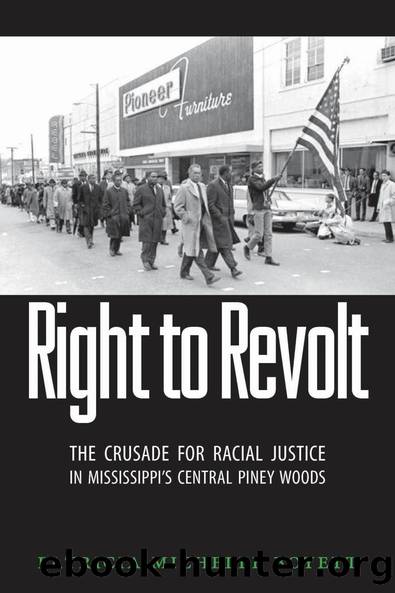Right to Revolt by Patricia Michelle Boyett

Author:Patricia Michelle Boyett [Boyett, Patricia Michelle]
Language: eng
Format: epub
Tags: Social Science, Discrimination, History, Social History, Ethnic Studies, American, African American & Black Studies
ISBN: 9781496804310
Google: A5rhCgAAQBAJ
Publisher: Univ. Press of Mississippi
Published: 2015-11-23T04:08:28+00:00
CHAPTER 7
Trials of the Ku Klux Klan
AT 7:40 P.M. ON SEPTEMBER 29, 1967, KLANSMAN BILLY ROY PITTS ENtered room 334 at the Admiral Bendow Inn in Jackson and informed FBI agents Robert Lee and William Dukes that he had murdered Vernon Dahmer. There was no turning back. The tall, ruddy-faced Klansman betrayed his Klan brothers and joined forces with the FBI. Late into the night, Pitts led agents on a bloody trail of Klan attacks and into the heart of the Invisible Empire as he unveiled its secrets, its members, and its power over Mississippi. When Pitts spoke of Dahmerâs murder, he revealed facts that agents had spent nearly twenty-one months trying to confirmâthe identities and roles of all of the killers.1
The turning of Billy Roy Pitts in the DABURN investigation proved even more significant than the turning of Klansmen James Jordan and Doyle Barnette in the Neshoba murders of three civil rights workers in the MIBURN case. Pittsâs klavern, located in Bowersâs hometown of Laurel, was the headquarters for the Invisible Empire. He had extensive knowledge of the inner workings of the White Knights and knew the crimes of the top echelon. Pitts not only provided agents and local prosecutors with a wealth of evidence to convict Dahmerâs killers but also significant information about other cases, including the Watkins kidnapping and the Klan terror campaign at Masonite. Although the MIBURN trial could produce significant federal convictions, to fully dismantle the Invisible Empire, the FBI needed the state to send Klansmen to prison on murder charges. Prior to Pittsâs confession, District Attorney Jimmy Finch informed agents that he needed more evidence before he could consider charging the DABURN suspects. Without the testimony of a participant, the Department of Justice also refrained from proceeding with a federal trial, as an acquittal might spur Klan growth. With Pittsâs confession, prosecutors had the evidence to develop their case. The recipe for the Klanâs destruction needed one more ingredientâlocal juries willing to return guilty verdicts. With Pitts on board, Finch was confident that he could deliver convictions. The White Knights were about to suffer for one of their worst mistakesâthe mistreatment of Billy Roy Pittsâfor he betrayed them all, and his confession tore down the walls of the Invisible Empire.2
Pittsâs narrative of Dahmerâs murder was not the only theory circulating. Klan informant Delmar Dennis remained devoted to the six-man theory. The FBI concluded that since Pitts participated in the attack, âit would appear likely that his information would be more accurate than the information furnished [by Dennis] allegedly by Sam Bowers, as it is conceivable that Bowers put out an erroneous story in an effort to confuse the information which was being gathered at the time.â Moreover, Pittsâs confession corroborated statements from other participants and conspirators and matched the evidence found at the crime scene, including the pistol, which Pitts revealed belonged to him. Federal and local prosecutors built their cases around Pittsâs confession. Pitts tried to convince his best friend in the Klan,
Download
This site does not store any files on its server. We only index and link to content provided by other sites. Please contact the content providers to delete copyright contents if any and email us, we'll remove relevant links or contents immediately.
Warrior Queens & Quiet Revolutionaries by Kate Mosse(299)
A Rome of One's Own by Emma Southon(277)
Executive Order No. 9066: The Terrible Injustice Of 1942 by Sollace Freeman(271)
The Evidence of Things Not Seen by James Baldwin(268)
The Explorers by Amanda Bellows(246)
Respectability and Reform by Tara M. McCarthy(243)
A Wider Type of Freedom: How Struggles for Racial Justice Liberate Everyone by Daniel Martinez HoSang(221)
The Grey Eagles of Chippewa Falls by John E. Kinville(191)
Liberty's Dawn: A People's History of the Industrial Revolution by Emma Griffin(190)
Rethinking White Societies in Southern Africa by Duncan Money(190)
Letters From London by Julian Barnes(185)
The Crosswinds of Freedom by James MacGregor Burns(182)
A Troublemaker May Surprise (The Troublemaker Series Book 2) by Genta Sebastian(175)
Evolution of Slavery Through the Ages: A Comprehensive World History of Slavery by PRESS VERITY(168)
A Teacher's Guide to Ladies of Liberty by Cokie Roberts Amy Jurskis(160)
Continental Strangers by Gemunden Gerd;(160)
The Slave Ship, Memory and the Origin of Modernity by Martyn Hudson(153)
Beware the Masher by Kerry Segrave(143)
Hunger Dark Pen by Dark Pen(141)
